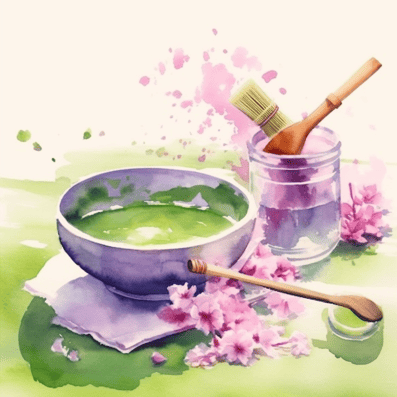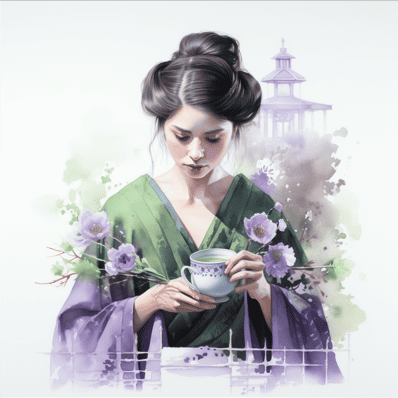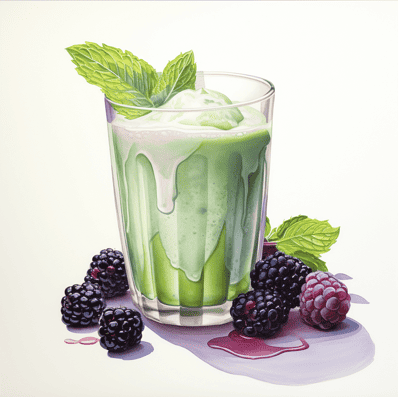
Don’t want to read the whole post?
Ceremonial matcha is prized for refined taste in tea ceremonies and you will find a price tag to match. Meanwhile culinary matcha is a more affordable version that offers robust flavours in budget-friendly recipes.
It’s best to try both at least once, to truly appreciate the attributes of ceremonial vs. culinary matcha.
ABOUT ME
Be beauty. Be plant-based!
As a former Registered Nurse and avid plant-muncher, I’m in love with how simple plant-based foods make it so easy to be beautiful.

You might also like:
From Bitter to Better: Distinguishing Good Matcha vs Bad Matcha
Matcha Magic: The Power of Green Tea for Acne-Free Skin
In the enchanting world of matcha, where vibrant green hues and rich flavours collide there is an important distinction to make: ceremonial vs culinary matcha. To understand which type of matcha is best for you, you will need to understand the differences in price and quality between them.
When selecting the best matcha for you, it is crucial to consider your intended use and personal preferences. The different matcha grades are:
Ceremonial matcha. Prized for its refined taste, ceremonial matcha is suitable for traditional tea ceremonies and savouring on its own.
Skip to: Is Ceremonial Matcha Worth the Money?
Culinary matcha, with its robust flavours, is the go-to grade for those looking to explore matcha-infused recipes and enjoy the benefits of matcha in a more budget-friendly way.
Skip to: Culinary Matcha: Versatility in the Kitchen
Premium matcha is a third grade which you should also be aware of. It’s a higher quality than culinary matcha, offering a balance between quality and versatility. This makes it a popular choice for both drinking and culinary applications.
What is Matcha?
Matcha is a type of green tea known for its vibrant green colour and fine powder texture. It is derived from the same plant which provides the green tea leaves for regular green tea, known as Camellia sinensis. What sets matcha apart is the way it is cultivated and processed.
You may also like:
Matcha Magic: The Power of Green Tea for Acne-Free Skin
Understanding the Types of Matcha
There are three different grades of matcha: ceremonial, culinary and premium.
The grading of matcha is a reflection of the careful cultivation, harvesting, and processing techniques employed. It is these factors that contribute to the unique characteristics and qualities of each grade.
Pure Elegance in Every Sip: Ceremonial Matcha
Ceremonial-grade matcha represents the pinnacle of matcha excellence. It is considered the highest quality of matcha available.
To ensure the finest quality, ceremonial matcha is cultivated with great care.

The tea plants are shaded for several weeks before the harvest, which encourages the leaves to produce more chlorophyll and amino acids. This shading process enhances the natural sweetness and umami flavour and gives ceremonial matcha its vibrant green color. The tea leaves are then hand-picked, selecting only the top leaves and buds to ensuring the finest and most tender parts of the leaves are selected. Only the youngest tea leaves are used and are usually harvested in the first flush, also known as “first harvest”. The resulting ceremonial matcha is vibrant green in colour, with a smooth and velvety texture and a delicate flavour profile.
One of the distinguishing factors of ceremonial matcha is its purity. It contains no additives or fillers, offering a concentrated form of green tea. It has a nuanced flavour and is often described as vegetal, slightly sweet, and with a hint of umami.
In traditional Japanese tea ceremonies, ceremonial matcha holds immense cultural significance. These ceremonies are rooted in centuries-old traditions and rituals, highlighting the reverence and appreciation Japanese people have for matcha. In fact the preparation of ceremonial matcha is an art form in itself, involving precise movements and the use of specialised utensils. The powdered matcha is whisked with a bamboo whisk with grace and mindfulness, creating a serene and meditative experience for both the host and the guests. Then it forms a frothy and smooth concoction.
If you’re seeking an authentic and traditional matcha experience, ceremonial matcha delivers in terms of taste and aroma.
Ceremonial vs culinary matcha: Is Ceremonial Worth the Money?
The question of whether ceremonial matcha is worth the price premium is a common one among matcha newbies. It really depends on what you intend to use the matcha for.
If the taste of matcha is very important to you, then ceremonial matcha might also be for you. It has a sweet taste and less bitter flavour due to the shading process and use of younger tea eaves.
Otherwise, ceremonial matcha is primarily used for tea ceremonies, where the highest quality matcha and presentation are of the utmost importance. The intention behind these ceremonies is to savour each sip mindfully, appreciating the essence and spirit of matcha. The ceremonial grade ensures a heightened sensory experience, creating a sense of tranquility and connection. In this respect, its value lies in the meticulous cultivation, harvesting, and processing methods involved. The attention to detail and limited availability then also contribute to its elevated cost.
Therefore if you wish for a moment of natural elegance, ceremonial matcha is the perfect choice. Its delicate flavor, vibrant green hue, and connection to ancient tea ceremonies make it a special and memorable tea. Whether you enjoy it in the traditional Japanese tea ceremony or simply as a moment of tranquility in your busy day, ceremonial matcha provides a sip of timeliness elegance that transcends the ordinary.
Versatility in the Kitchen: Culinary Matcha

Culinary matcha powder is for those looking to explore the culinary possibilities of matcha.
The uses of culinary matcha
While ceremonial matcha takes the spotlight for its elegance and tradition, culinary matcha, as the name suggests, is primarily used for culinary purposes. Compared to the young tea leaves of ceremonial matcha, culinary matcha is made from older tea leaves, typically harvested in the later harvests. These leaves may have more robust flavours and a slightly different profile compared to ceremonial or premium matcha. This also makes culinary matcha a more accessible and budget-friendly option, as it’s an excellent choice for different uses in the kitchen, such as incorporating into baked goods, smoothies, and other culinary creations.
The taste of culinary matcha
When distinguishing between ceremonial vs culinary matcha, be mindful that culinary matcha possesses a slightly more bitter taste compared to its ceremonial counterpart. However, this flavour profile lends itself well to various culinary creations, adding depth and complexity to dishes. The colour of culinary matcha may also vary, ranging from a vibrant green to a deeper shade, depending on the specific harvest and processing techniques.
From matcha-flavoured cakes, cookies, and muffins to matcha-infused sauces, dressings, and smoothies, culinary matcha brings a healthy, skincare friendly twist to a variety of dishes. It can also be used to create a range of delicious matcha lattes, offering a comforting and energising beverage.

That said, culinary grade matcha tea can also be satisfying, and is still very healthy for you.
If you fancy something other than matcha and hot water, check out these latte recipes:
It’s important to address the common misconception that culinary matcha is of lower quality matcha. While it may not possess the same level of refinement as ceremonial matcha, culinary matcha still undergoes a careful cultivation and processing process.
While it is made from slightly older tea leaves, this contributes to a more robust flavour profile. This doesn’t make culinary matcha’s value or versatility in the culinary realm of low quality. Just the opposite. Culinary matcha is specifically crafted to excel in the kitchen, offering a high-quality option for incorporating matcha into your favourite recipes.
Premium Matcha: The forgotten sibling
Premium grade matcha, also known as high-grade matcha, holds a noteworthy position between ceremonial and culinary grades. It is typically made from the first or second harvest, using slightly older tea leaves than ceremonial matcha. This grade still upholds a commendable quality, offering a balanced taste and vibrant green colour. While it may not possess the same level of refinement as ceremonial matcha, it remains a favourable choice for those seeking an elevated matcha experience.
The best way to decide between ceremonial and culinary matcha is to rely on your personal preference. If you prefer a smoother and more refined flavour profile, ceremonial matcha is the ideal option. Its delicate nature enhances the overall taste and and you can calmly indulge a new level of elegance. However, if you enjoy matcha with a slightly more robust and complex taste, culinary-grade matcha can deliver a satisfying and vibrant experience. Finally, if you want something in between the two, premium is the type of matcha for you.
Wellness bonus
Matcha contains a particularly high concentration of a specific amino acid called L-theanine. L-theanine is an amino acid that is naturally found in tea leaves, including matcha. It is known for its calming and relaxing effects on the mind and body, as well as improving cognitive function, by increasing the production of alpha waves in the brain without causing drowsiness. This unique amino acid is responsible for the balanced and focused energy that matcha is often associated with, differentiating it from the jittery effects of caffeine found in coffee.
In the realm of matcha, the distinction between ceremonial and culinary matcha becomes clear as we delve into their unique characteristics and purposes. While ceremonial matcha embodies grace, tradition, and the art of tea ceremonies, culinary matcha unleashes its vibrant flavours and versatility in the culinary world. Understanding the differences between these two varieties allows us to appreciate their individual strengths and harness their full potential. So whether you seek a moment of tranquility with ceremonial matcha or unleash your culinary creativity with culinary matcha, the choice is yours. Embrace the nuances of ceremonial vs culinary matcha and embark on a delightful journey into the world of matcha mastery.